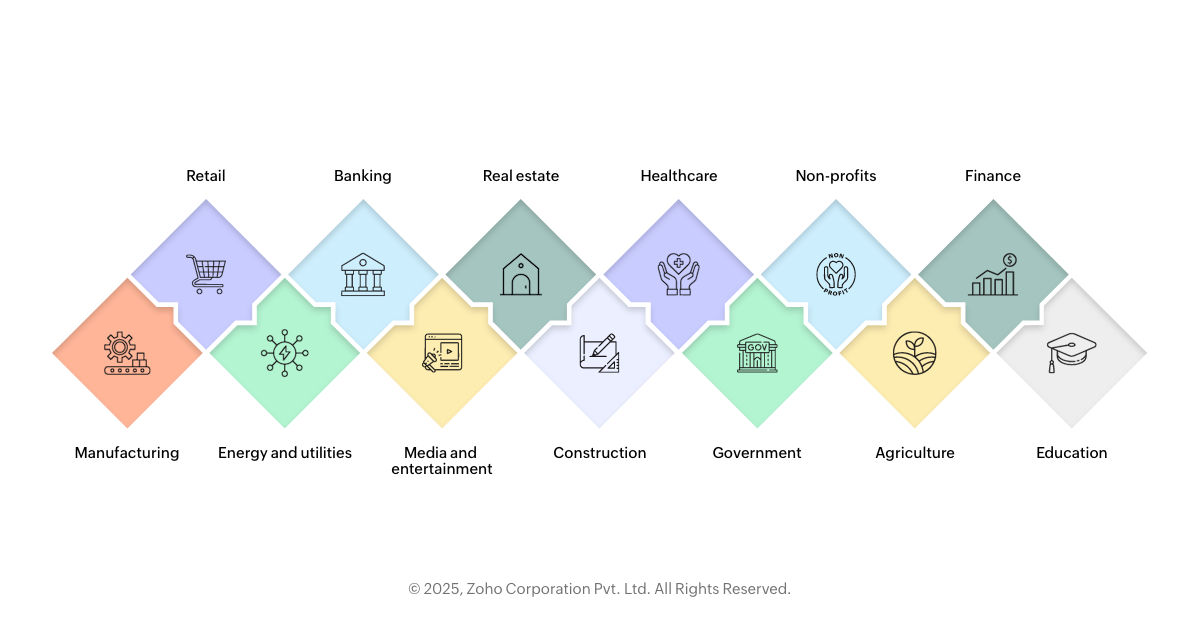13 powerful ways to leverage low-code technology
- Last Updated: June 3, 2025
- 654 Views
- 11 Min Read

Low-code platforms are versatile in nature, empowering line-of-business users and IT teams to deliver robust and scalable applications rapidly. This versatility allows them to be leveraged across a wide range of industries.
In this blog, we will explore diverse low-code use cases across industries like finance, healthcare, and retail, among many others. We will also look into how low-code helps streamline business processes and enhance productivity. In these use cases, we will highlight how these platforms empower non-technical users to build applications, making app development more inclusive.
1. Manufacturing
Creating goods has always been a profitable industry. To run their production lines with ease, more and more manufacturing firms are leveraging low-code platforms because of their utility.
Here are some key ways in which low-code apps are used in manufacturing industries.
Inventory management
The vast repertoire of assets in an organization's inventory can be managed efficiently by low-code applications. These applications monitor the status of the items in the inventory, offer granular insights into stock levels, and provide intelligent suggestions for quick stock replenishment to ensure the need for demand is always met.
Equipment maintenance scheduling
A factory's production relies on its machinery. This machinery should always be maintained in pristine condition. Low-code applications can be used for tracking the lifecycle of all the machinery in a manufacturing factory.
Reducing manual error
Digitization results in more accurate process execution. Human involvement in work processes always has an element of error included in it. Digitization reduces manual error in a manufacturing factory's everyday processes.
Ensuring quality control (QC) is another aspect of manufacturing that stands to benefit from low-code solutions. The solutions can create checklists of task items that need to be met before a product is released into the market for consumption. These checklists track quality criteria that need to be met for a product to be considered of optimum quality.
2. Retail
Digitized ecommerce is all the rage today. Why go to a store when you can order from the comfort of your home? This saves time and money, otherwise spent travelling to the store, buying the commodities, and returning back.
Low-code platforms can be leveraged by retail enterprises for the following categories.
Providing an omni-channel customer experience
The capability of low-code applications to integrate offline and online channels of store interaction is impeccable. Users of low-code applications can have a consistent shopping experience across physical stores and retail ecommerce interfaces. Customers can thus purchase effortlessly from the enterprise in multiple ways.
Point of sale solutions
You can also build point of sale (PoS) applications on top of low-code development platforms which provide a unified retail management solution. These solutions can process transactions, integrate with inventory to assess stock levels, and implement loyalty programs.
Check out here to learn about custom logistics software!
3. Energy and utilities
The energy and utilities sector, a crucial domain in contemporary times due to the impact of human activity on the environment, also stands to benefit from low-code applications.
Smart grid management
Advanced electricity networks that utilize software solutions to manage energy generation, distribution, consumption, and management are known as smart grids. Low-code applications can be built to oversee, monitor, and execute most or all aspects of smart grids, leading to improved eco-viability and environmental sustainability.
Regulatory compliance and reporting
Present times mandate companies to adhere to global environmental standards. This is because the energy sector is highly regulated. Low-code applications can enable the collection, maintenance, and supervision of energy pertinent data. This allows organizations to be compliant from a regulatory viewpoint, enhancing their stature of responsibility in the eyes of prospective customers and government personnel.
4. Banking
Traditionally, banks relied on specialized software solutions built specifically for banking to run their operations. These systems are often bloated, they take ages to implement into banking infrastructure, and some of them have become legacy software systems.
Harnessing a low-code platform to build specialized apps for banking is the new pathway to banking efficiency today.
Here are some examples of domains in banking where low-code solutions can be used.
KYC applications
Low-code platforms can be used to build know your customer (KYC) applications, which verify the details of a customer intending to make transactions using the bank. Document uploads and e-verification during account creation are some of the areas where low-code applications can be deployed.
Disbursal processing: loans and mortgages
Disbursal processing—including but not limited to loans and mortgage disbursal—can be automated using these platforms. Applications can be engineered to track every transaction a customer has with the banking establishment.
Digital banking
Portals built on top of these platforms can serve as secure digital banking gateways for consumers. Instead of having to visit a bank physically, portal-enabled digital banking—powered by applications built on low-code application development platforms—can facilitate banking from the comforts of the customer's location, wherever they may be, with only an internet connection being the prerequisite. Mobile apps are also a viable alternative for bank clients to access their accounts remotely.
5. Media and entertainment
Media and entertainment applications are used by everyone. You can use low-code platforms to engineer applications that render entertainment content consumption a breeze.
Event management
Events are everywhere. Be it professional events, trade shows, or even concerts, event management is a priority for those involved in it. Low-code platforms can be used to whip up event management applications (optionally in the form of mobile applications) that manage the lifecycle of an event from its inception to its execution, even including post-event follow-ups.
Event management applications built using these platforms typically contain modules for managing user registration, venue booking, ticket sales, and sale of event memorabilia.
Digital asset management
Imagine a centralized repository for all your media, be it audio or video. You can build a holistic media repository rapidly on a low-code platform with dashboards and analytics of the media. What is more, this can be done with minimal scripting on a low-code platform.
6. Real estate
With low-code solutions, the hegemony of third-party entities who manage properties is a thing of the past. Low code throws open the doors of property management to citizen developers.
Property listing applications
Why rely on third parties to list your properties when you can whip up your own property listing application on a low-code platform in mere days? You can even publish your low-code application so that others may also list their properties on it.
Property management systems
These applications built on a low-code platform allow the complete tracking of properties, from document management—such as deeds, contracts, rental agreements, lease agreements, and tenant interactions—to payments.
7. Construction
Digitization has lent its arms even to the construction industry, where digitization is generally viewed with apprehension due to the stakeholders' limited exposure to digital technology. However, low code has transformed this perspective. Now, stakeholders are empowered by the power of low-code platforms to ideate complex requirements into fully functional applications easily. These platforms can be leveraged to digitize the construction industry.
Asset management
Application development platforms can be utilized to build asset management applications that track all the assets (such as vehicles and equipment) owned by a construction entity. Equipment usage can be monitored to gauge their usability, and vehicles can be tracked periodically to ensure they remain fully functional without any hassles. Periodical servicing for vehicles can also be scheduled using low-code applications.
All this is done to ensure complete operational viability and the reduction in possible downtime caused due to equipment or vehicle malfunction.
Workforce management
Holistic workforce management systems can be built on top of low-code platforms. Personnel management is made easy by the use of visual dashboards that can be built by construction stakeholders themselves because of the user-friendly nature of low-code platforms. Tracking workforce allocation across different projects, wage management, individual task assignment, and labor management are all made simple by low-code applications.
8. Education
We are in the golden age of EdTech—the synergy between education and technology—and low-code solutions are poised to skyrocket this industry's fortunes in the coming years.
Student management applications
Right from enrolling in a course/program to tracking grades, providing feedback to graduating, low-code platforms can be used to whip up applications that manage students holistically. Teachers and student managers can use low-code applications and workflows to govern students seamlessly.
Education learning management systems
Learning used to be predominantly book based, but with the advent of high speed broadband and EdTech software, online learning and online classes have slowly emerged as a viable alternative. Low-code applications can be used to develop applications that serve as a learning management system (LMS) for education. These will store digitized courses, course work material, and evaluation modules. Students can learn from anywhere, with the requirements being just an internet connection and, of course, enrollment.
9. Finance
The finance sector has become radically digitized in contemporary times, with a great proportion of transactions taking place online these days. This has led to increased customer satisfaction and reduced burden on the business stakeholders.
Loan and mortgage processing
You can automate the entire process—from loan application to disbursement—using low-code platforms. No paperwork is needed; only digitized documents are required. Mortgage procedures can also have their processes similarly automated. This speeds up the financial processes, leading to quick turnaround times for business stakeholders and increased customer satisfaction for clients.
Portfolio management
You can also build low-code applications for holistic portfolio management. Keep track of your financial assets, manage them from a centralized dashboard, and run advanced analytics on them with tools built using drag-and-drop interfaces.
Portfolio management has never been easier.
10. Agriculture
The primeval endeavor of man—agriculture—now stands to benefit massively from the huge leaps and strides made in technology. Rapid application development platforms like low-code platforms can now be leveraged to manage this crucial sector efficiently.
Farm management systems
Complete farm management systems can be built through low-code powered application development and business process automation. These can track crop spread, crop distribution, inputs, fertilizer consumption, and pesticide usage. You can also add modules for equipment and vehicle monitoring to schedule periodic maintenance and perform repairs if needed.
Worker and contractor management
Though huge chunks of today's agricultural efforts are mechanized, there is still a demand for a pair of human hands to do some work in the field. Applications built on low-code platforms can be used to manage workers and contractors granularly, perform productivity tracking, and credit wages periodically based upon output.
Livestock management
Livestock makes up the core essence of the dairy sector. Livestock management applications allow for easy handling of huge swarms of livestock. Their health can be tracked, outputs measured, and vaccines can be scheduled to be administered periodically, all from the application's dashboards and automated workflows. The best part? With low-code platforms, even the business stakeholders in livestock management can create applications by themselves for process execution.
11. Non-profits
These enterprises that function for noble causes benefit tremendously from low-code platforms.
Donor management systems
Non-profits thrive and survive based on donations made by donors. Applications built for donation management can be used to track the details of donors and benefactors, and the donations made.
Impact assessment applications
The impact made by non-profits on the environment and on society is vital and crucial. Applications that document the impact made will be quintessential in assessing the efficacy of a non-profit's operations and will identify the scope for improvement.
Volunteer management applications
Volunteers are the life-blood of a non-profit's workforce. A system to manage them effectively can be architected with low code quickly and easily—even by the non-profit's stakeholders themselves—due to the ease of application building using low code.
12. Government
On premises low-code application development platforms—where the applications built on the platform are hosted within an enterprise's own servers—are the go-to choice for governments because of their requirements for rapid application development and business process automation.
Legacy modernization
Governments usually run on ancient, clunky, bloated, legacy systems and outdated software. Low-code platforms—with their rapid digital transformation capabilities—can be quickly harnessed by governmental departments to transition from legacy architecture to sleek, ultramodern low-code applications.
Workflows, which used to take ages with legacy software, can be hastened and executed in moments via ultramodern applications that are automatically scalable and are highly efficient.
E-governance
Empowering the citizen is the core tenet of any government that is seeking to accelerate their initiatives by harnessing the power of low code. Portal-based access for citizens built using low code will eliminate bureaucratic red tape, reduce transaction times, and increase citizens' happiness quotient.
Citizens can also access all their information through secure government portals that are quickly built using low code. This eliminates wait times and speeds up citizen-government interactions.
Calamity management
Consider that there is a natural disaster. Software is required to speed up relief efforts. Going the traditional way would take a lot of time and won't be a pragmatic approach. You can harness the power of low code here and build relief management applications that can co-ordinate rescuers with the afflicted—much faster than traditional coding and traditional software development approaches.
13. Healthcare
The healthcare sector, which is highly regulated, is poised to reap a lot from the low code revolution.
Patient management systems
With low code, you can quickly and easily build complete patient management systems. These serve as centralized repositories for doctors to view all pertinent information about their patients, including but not limited to their medical history, medications they're on, and their hospital stay, as well as details of their diagnoses.
These patient management systems assist in improving the care rendered by hospitals to their patients.
Clinical support
Low-code development platforms can be used to develop applications for healthcare use cases like appointment scheduling, clinic personnel management, and clinical administration.
These improve the quality of service rendered by the healthcare provider to their clientele.

Leverage business process automation
Any organization abounds with business processes. These processes are responsible for the day-to-day operations of the organization. Here are some areas in business process automation where low code has use cases.
Workflow automation
Workflows in an organization tend to be repetitive, and often become mundane. Low-code solutions can automate repetitive workflows, reduce bottlenecks in business process automation, and streamline workflows for improved efficiency.
Customer service automation
Low-code applications empower customers by streamlining the processes responsible for turnaround time. They can reduce the time customers spend interacting with the organization as well as reduce the workload of customer-facing teams. Efficient customer service automation is facilitated by low-code platforms, which often improve customer satisfaction.
Click here to learn more features of workflow automation!
Low-code use cases
Low-code development platforms are application powerhouses. Their ability to whip up software applications and automate complex business processes rapidly is of great use in a wide array of industries today. For your industry, identify the processes that need automation and the applications that require development, then leverage a low-code platform that matches your needs, and automate away.
Low-code use cases are found in almost any industry that can benefit from digitization and custom applications today.
The rapid development capabilities of low-code platforms make them an ideal choice for quick and effective digital transformation. Also, the low-code approach is now increasingly sought after due to its versatility. Transition to the best low-code platform today. Reap the benefits of low-code platform now.
Why choose ManageEngine AppCreator for low-code app development?
With the increasing adoption of low-code platforms, selecting the right platform for your organization can be daunting. Although many may appear similar at first, the differences in features, scalability, and integration can greatly impact long-term success. ManageEngine AppCreator stands out by delivering flexibility and support for a wide range of use cases, making it an easy-to-use multipurpose option for organizations.
AppCreator is a versatile low-code platform designed to help organizations create custom applications quickly and easily. With an intuitive drag-and-drop interface, it empowers users of all skill levels to build apps using predesigned templates and workflows. The platform ensures robust security with features like data encryption and role-based access, ensuring applications meet compliance requirements. AppCreator simplifies the app development process, cuts down on costs, and speeds up deployment, making it the perfect solution for organizations looking to streamline operations.
The platform supports a wide range of use cases across a large array of industries. Its capabilities are enhanced through Deluge, a simple scripting language that enables users to add complex business logic and extend app functionality easily without requiring deep coding knowledge. This ensures tailored solutions for diverse business needs.
If you're seeking a low-code platform to enhance your app development process, explore AppCreator with a free 30-day trial. Sign up now to get started!



